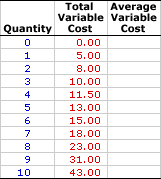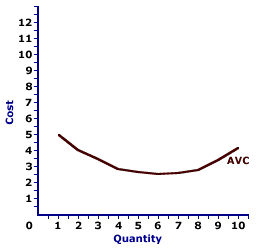
|
|
FACTORY: The building and equipment (the physical capital) at a particular location used for the production of goods and services. A factory often takes the form of the conventional assembly-line system, but it need not. As the building and equipment used for production, a factory can also be restaurant, doctor's office, or university classroom. Moreover, while a factory is often associated with the notion of firm or business, they need not be one and the same. A firm can, often does, own more than one factory and a factory can be owned by more than one firm.
Visit the GLOSS*arama
|
|


|

|
                           AVERAGE VARIABLE COST: Total variable cost per unit of output, found by dividing total variable cost by the quantity of output. When compared with price (per unit revenue), average variable cost (AVC) indicates whether or not a profit-maximizing firm should shut down production in the short run. Average variable cost is one of three average cost concepts important to short-run production analysis. The other two are average total cost and average fixed cost. A related concept is marginal cost. Average variable cost is the total variable cost per unit of output incurred when a firm engages in short-run production. It can be found in two ways. Because average variable cost is total variable cost per unit of output, it can be found by dividing total variable cost by the quantity of output. Alternatively, because total variable cost is the difference between of total cost and total fixed cost, average variable cost can be derived by subtracting average fixed cost from average total cost.In general, average variable cost decreases with additional production at relatively small quantities of output, then eventually increases with relatively large quantities of output. This pattern is illustrated by a U-shaped average variable cost curve. Average variable cost, when combined with price, indicates whether or not a firm should shut down production in the short run. If price is greater than average variable cost, then the firm is able to pay all variable cost and a portion of fixed cost. Even though it might be incurring an economic loss, it will lose less by producing that by shutting down production. If, however, price is less than average variable cost, then the firm is better off shutting down production. Calculating Average Variable CostThe standard method of calculating average variable cost is to divide total variable cost by the quantity, illustrated by this equation:| average variable cost | = | total variable cost
quantity of output |
An alternative specification for average variable cost is found by subtracting average fixed cost from average total cost:| average variable cost = average total cost - average fixed cost |
An alternative equation computes total variable cost from average variable cost:| total variable cost = average variable cost x quantity of output |
Stuffed Animal Cost| Average Variable Cost | 
|
Insight into average variable cost can be had using the table to the right, which presents the total variable cost of producing Wacky Willy Stuffed Amigos. The first column is the quantity of Stuffed Amigos rolling off the assembly line, ranging from 0 to 10. The second column is the total variable cost of producing each quantity, ranging from $0 to $43. If 5 Stuffed Amigos are produced, then the total variable cost incurred in their production is $13. The production of 9 Stuffed Amigos, in comparison, incurs a total variable cost of $31.Deriving average variable cost is as simple as dividing the second column of total variable cost values by the first column of output quantity values. The average variable cost of producing 1 Stuffed Amigo is relatively easy--divide $5 by 1 Stuffed Amigo. If the result of this calculation is not readily obvious, click the [One] button. The average variable cost of two Stuffed Amigos might be a little less obvious, but not much. Click the [Two] button to reveal that the average variable cost is $4, which is $8 divided by 2 Stuffed Amigos. A click of the [Three] shows that the average variable cost of producing 3 Stuffed Amigos is $3.33, $10 divided by 3. The remaining average variable cost values can be displayed by clicking the [Remaining] button. With all numbers displayed, what interesting insight into average variable cost can be had? - First, average variable cost is relatively high for the first Stuffed Amigo produced, then declines. However, it reaches a low, then rises with production of the last few Stuffed Amigos. This is the U-shaped pattern noted above.
- Second, average variable cost remains positive, it never reaches a zero value and never turns negative. The only way for negative average variable cost is for negative total variable cost, which makes no theoretical or practical sense.
The Average Variable Cost Curve| Average Variable Cost Curve |  |
The relation between average variable cost and the quantity of production can be represented by a curve, such as the one conveniently presented in the exhibit to the right.The key feature of this average variable cost is the shape. It is U-shaped, meaning it has a negative slope for small quantities of output, reaches a minimum value, then has a positive slope for larger quantities. This U-shape is indirectly attributable to the law of diminishing marginal returns. The U-shape of the average variable cost curve is indirectly caused by increasing, then decreasing marginal returns (and the law of diminishing marginal returns). The negatively-sloped portion is attributable to increasing marginal returns and the positively-sloped portion is attributable to decreasing marginal returns (and the law of diminishing marginal returns).

Recommended Citation:AVERAGE VARIABLE COST, AmosWEB Encyclonomic WEB*pedia, http://www.AmosWEB.com, AmosWEB LLC, 2000-2025. [Accessed: July 18, 2025].
Check Out These Related Terms... | | | | | | | | | | | |
Or For A Little Background... | | | | | | | | | | | |
And For Further Study... | | | | | | | | | | | | | | | | | | |
Search Again?
Back to the WEB*pedia
|



|

|
WHITE GULLIBON
[What's This?]
Today, you are likely to spend a great deal of time searching the newspaper want ads seeking to buy either an extra large beach blanket or a large flower pot shaped like a Greek urn. Be on the lookout for fairy dust that tastes like salt.
Your Complete Scope
This isn't me! What am I?
|

|
|
Mark Twain said "I wonder how much it would take to buy soap buble if there was only one in the world."
|

|
|
"A winner is someone who recognizes his God-given talents, works his tail off to develop them into skills, and uses those skills to accomplish his goals. " -- Larry Bird, basketball player
|

|
CLI
Cost of Living Index
|

|
|
Tell us what you think about AmosWEB. Like what you see? Have suggestions for improvements? Let us know. Click the User Feedback link.
User Feedback
|


|


